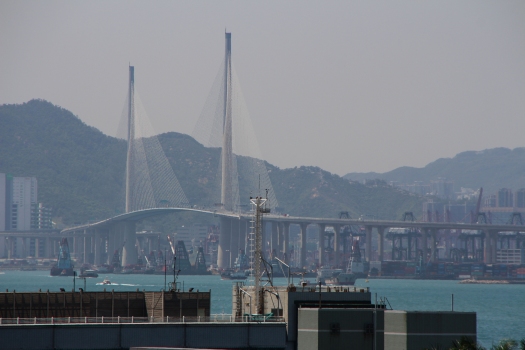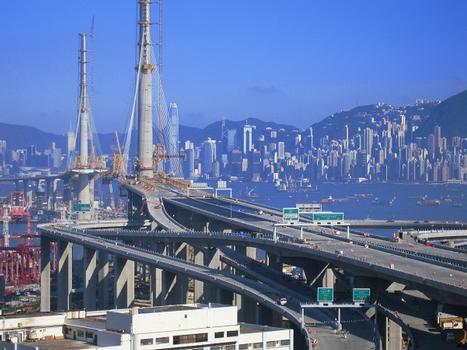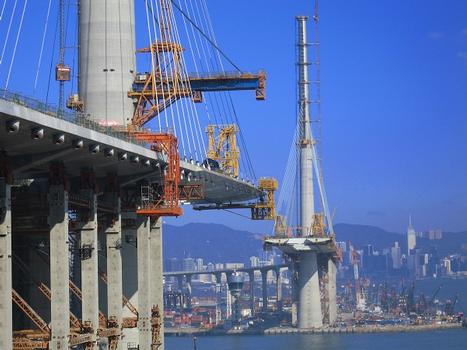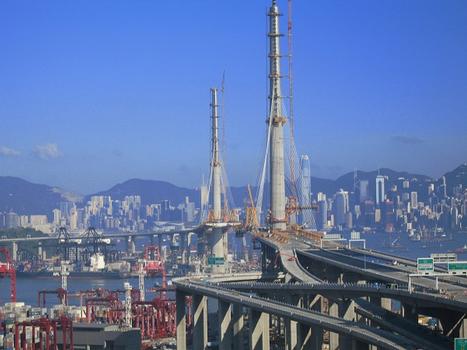General Information
Project Type
| Structure: |
Cable-stayed bridge with semi-fan system |
|---|---|
| Function / usage: |
Motorway bridge / freeway bridge |
| Material: |
Steel bridge |
| Secondary structure(s): |
Structurae Plus/Pro - Subscribe Now! |
Awards and Distinctions
| 2011 |
finalist
for registered users |
|---|
Location
| Location: |
Tsing Yi, Kwai Tsing, Hong Kong, China |
|---|---|
| Part of: | |
| Connects to: |
Ngong Shuen Chau Viaduct (2007)
|
| Coordinates: | 22° 19' 33" N 114° 7' 6" E |
Technical Information
Dimensions
| main span | 1 018 m | |
| length of side spans | 2 x 289 m | |
| deck | deck width | 51 m |
| pylon | pylon height | 293 m |
| dimensions of pylon foot | 24 m x 18 m |
Materials
| deck of main span |
steel
|
|---|---|
| deck of side spans |
concrete
|
| pylon (below deck level) |
concrete
|
| pylon (above deck level) |
concrete with stainless steel skin
|
Chronology
| January 2000 | An International Design Competition is launched. |
|---|---|
| September 2000 | The winning scheme is announced. |
| March 2001 | The design consultancy is awarded. |
| July 2003 | Tender Period. |
| April 2004 | Construction contract is awarded. |
| December 2009 | The bridge is opened to traffic. |
Notes
The concept for the Stonecutters Bridge was selected through an international design competition which took place in year 2000.
Excerpt from Wikipedia
Stonecutters Bridge is a high level cable-stayed bridge spanning the Rambler Channel in Hong Kong, connecting Nam Wan Kok, Tsing Yi to Stonecutters Island. The bridge deck was completed on 7 April 2009, and opened to traffic on 20 December 2009. The bridge was the second-longest cable-stayed span in the world at the time of its completion.
The approaches at Tsing Yi and Stonecutters Island are located near Container Terminal 9 and Container Terminal 8, respectively.
The bridge is part of Hong Kong's Route 8, connecting Sha Tin, Cheung Sha Wan, Tsing Yi island, Ma Wan and Lantau Island. Other major constructions along the route are Nam Wan Tunnel (completed in 2008), Eagle's Nest Tunnel (completed in 2008), Sha Tin Heights Tunnel (completed in 2008), Tsing Ma Bridge (completed in 1997) and Kap Shui Mun Bridge (completed in 1997).
The Stonecutters Bridge won the 2010 Supreme Award at the annual Structural Awards presented by the Institution of Structural Engineers, United Kingdom.
History
Construction commenced on 27 April 2004 by Maeda-Hitachi-Yokogawa-Hsin Chong JV (a joint venture of Maeda Corporation, Hitachi Zosen Corporation, Yokogawa Bridge Corporation, and Hsin Chong). It cost HK$2.76 billion. It was reported to be over budget.
Structure
The bridge spans 1.6 km (0.99 mi), with 3 lanes in each direction. It is a cable-stayed bridge with two bridge towers, one on Tsing Yi Island and the other on Stonecutters Island.
With a main span of 1,018 m (3,340 ft), Stonecutters Bridge has the third-longest cable-stayed span in the world, after the Sutong Bridge and Bridge to Russky Island.
It was built at a cost of HK$2.76 billion.
Bridge design
The design concept for the bridge was procured by Highways Department in Hong Kong through an international design competition. The winning scheme was the one presented by a group consisting of bridge architect Dissing+Weitling together with engineering firms Halcrow Group, Flint & Neill and Shanghai Municipal Engineering Design Institute. The design was selected as the Reference Scheme for the further design development. A group led by Arup with COWI A/S as main sub-consultant has carried out the further design development of the Reference Scheme and the detailed design that followed.
The concept was for a cable-stayed bridge with a twin aerodynamic deck suspended from two 295m-high single pole towers. These towers have bases measuring 24m x 18m tapering to 7m diameter at the top, and the deck allows a navigation clearance of 73.5m over the full entrance to the Container Port.
The two towers are in concrete until level +175m and in composite construction consisting of an inner concrete ring with a stainless steel skin for the top 120m. The original concept had a conventional steel structure above level +175m but Arup found that this configuration would be too lively and lead to unacceptable vibrations of the stay cables. Using a heavier composite section instead of a pure steel structure solved this problem. For reasons of durability and to enhance the appearance, further studies concluded that the tower skin should be fabricated from a duplex stainless steel (grade 1.4462 to BSEN10088) with a shot peened surface finish. The deck itself is made of steel in the main span and of concrete in the side spans.
The tower foundations are located within 10m of the seawall on either side of the Rambler Channel, close to the back-up land next to CT8 and CT9. Their proximity to the channel necessitated ship impact testing and modelling. Geotechnical centrifuge testing was conducted using a 1:200 scale model of a vessel bow section and seawall within a container.
Wind studies
The Hong Kong region is susceptible to very strong typhoon winds, a fact that was taken into account in the design of the bridge. In October 2002 a 50 m (160 ft) mast was erected at the site to measure the speed, direction and turbulence of winds in the area. Readings, which continued until January 2004, were transmitted in real-time to an offsite location for further analysis. In particular, the stability of the 509 m (1,670 ft) long cantilevers during construction required special consideration in the design.
Text imported from Wikipedia article "Stonecutters Bridge" and modified on July 22, 2019 according to the CC-BY-SA 4.0 International license.
Participants
- Halcrow Group
- Shanghai Construction Engineering Group
-
Dissing+Weitling arkitektfirma a/s
- Poul Ove Jensen (concept designer)
-
Flint & Neill
- Ian Firth (concept designer)
Relevant Web Sites
Relevant Publications
- (2008): 4000 tonne lift of Stonecutters Bridge steel back-spans, H.K.. In: Proceedings of the Institution of Civil Engineers - Bridge Engineering, v. 161, n. 4 (December 2008), pp. 197-208.
- (2006): Advances in Cable-Supported Bridges. Taylor & Francis, Abingdon-on-Thames (United Kingdom), pp. 261.
- (2010): The Aerodynamic Behaviour of the Deck of Stonecutters Bridge, Hong Kong. In: Structural Engineering International, v. 20, n. 1 (February 2010), pp. 79-90.
- (2010): Aerodynamic Behaviour of Very Long Cable-Stayed Bridges during Construction. Presented at: IABSE Symposium: Large Structures and Infrastructures for Environmentally Constrained and Urbanised Areas, Venice, Italy, 22-24 September 2010, pp. 292-293.
- Aesthetics retained as Stonecutters detailed design starts. In: Bridge Design & Engineering, v. 8, n. 26 (1st Quarter 2002), pp. 8.
- About this
data sheet - Structure-ID
20000930 - Published on:
08/09/2000 - Last updated on:
28/11/2018















